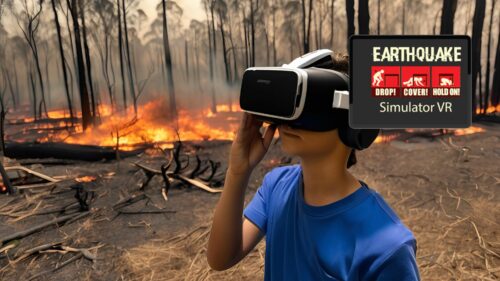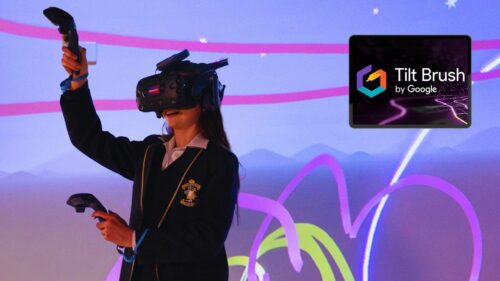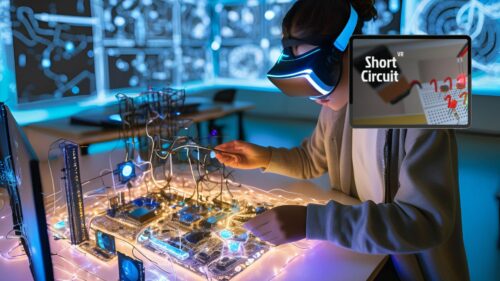Task Summary
Students will form some hypotheses about the future impact melting ice-caps will have on the world after engaging with the virtual reality (VR) experience Iceland is Melting.
Learn MorePreparation
Students are expected to:.
- Have some background in viewing Youtube videos in VR on the HHVR headsets.
- Have been studying the concepts of how human activities have had an impact on environmental change.
Teachers should make sure that:
- Devices are charged.
- Students are able to access all listed websites
- Slide deck has been checked and the teacher has access
- A copy of the Student Digital Notebook has been distributed to students and they have downloaded/ made a copy for themselves.
- Students have been prepped with pre-required understanding to complete the learning of this lesson
- Students are divided into pairs or groups depending on how many devices are available. A suggested rotation cycle may be:
| Group | Round 1 | Round 2 | Round 3 |
| Group 1 | HHVR | Research | Image Study |
| Group 2 | Image Study | HHVR | Research |
| Group 3 | Research | Image Study | HHVR |
This may differ based on student numbers and number of HHVR headsets/ devices.
Learning Sequence
- Begin by sharing with students the difference between a human-centred and an earth-centred worldview on Climate Change. Students record their thoughts in their Student Digital Notebook on;
- What statements do you agree with and
- Where do you feel you sit most?
- As a class, discuss the difference between natural and human induced climate change.
Ask students to access the following website Natural Vs Anthropogenic Climate Change and ask them to complete a 4 C’s thinking routine on the text in their Student Digital Notebook:-
- Connections: What connections do you draw between the text and your own life or your other learning?
Challenge: What ideas, positions, or assumptions do you want to challenge or argue with in the text?
Concepts: What key concepts or ideas do you think are important and worth holding on to from the text?
Changes: What changes in attitudes, thinking, or action are suggested by the text, either for you or others?
- Connections: What connections do you draw between the text and your own life or your other learning?
-
Station-based Experiences
- Divide students into 3 groups. Rotate groups through each station (10 mins each station). Students should record their thinking and interactions with each station in their Student Digital Notebook.
Station 1 – Research
Students study the impacts and management of human induced climate change in Australia and at least one other country and compare.
What other glaciers are being affected? – Alaska’s Columbia Glacier & Mt. Ararat
Station 2- Image study – Images of change
Students study the following images, read the captions and complete a Connect Extend Challenge on each one:
- Arctic Sea Ice
- Greenland Ice Melt
- Early Sea Ice Breakup
- Shrinking Glaciers Antarctica
- Shrinking Ice cap – Iceland
- Connect, Extend, Challenge: Consider what you have just read, seen, or heard, and then ask yourself:
- How are the ideas and information connected to what you already knew?
- What new ideas did you get that broadened your thinking or extended it in different directions?
- What challenges or puzzles emerge for you?
- Connect, Extend, Challenge: Consider what you have just read, seen, or heard, and then ask yourself:
Station 3 -HHVR
Students to watch CNN: Iceland is Melting on the Within app using the HHVR.
Once they have finished watching, they can answer the following questions with their opinions in their Student Digital Notebook :
- What are the causes and consequences of change in environments and how can this change be managed?
- How are the changes in these arctic environments going to impact us here in Australia?
- Have students engage with a +1 Routine in their Student Digital Notebook to finish recapping and synthesizing new information from the lesson.
-
-
- Recall
In 2-3 minutes and working individually, each learner generates a list of key ideas that he or she recalls from the presentation that they feel is important to hang onto. Learners do this from memory rather than reviewing notes or material. - Add (+) 1
Learners pass their papers to the right. Taking 1-2 minutes, each student reads through the list in front of him/her and adds one new thing to the list. The addition might be an elaboration (adding a detail), a new point (adding something that was missing), or a connection (adding a relationship between ideas). - REPEAT this process at least two times.
- Review
Return the papers back to the original owner. Learners read through and review all the additions that have been made on their sheets. At the same time they may add any ideas they have picked up from reading other’s sheets that they thought were worthwhile.
- Recall
-
Download the PDF for more information



